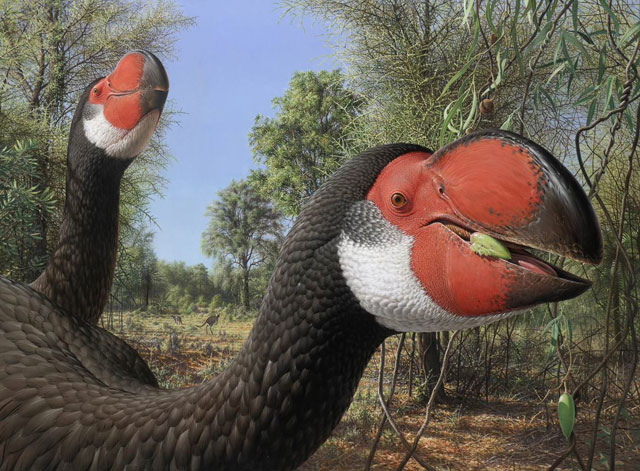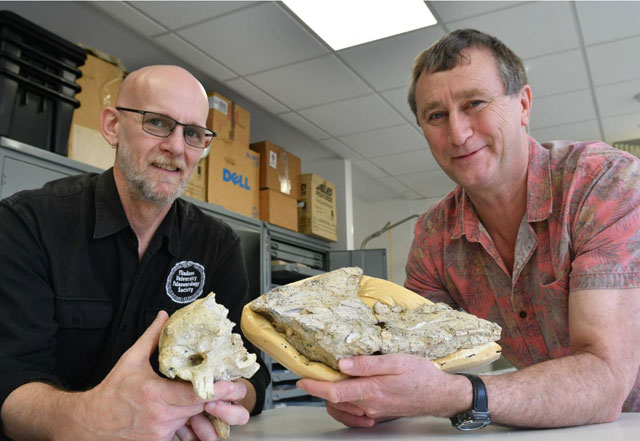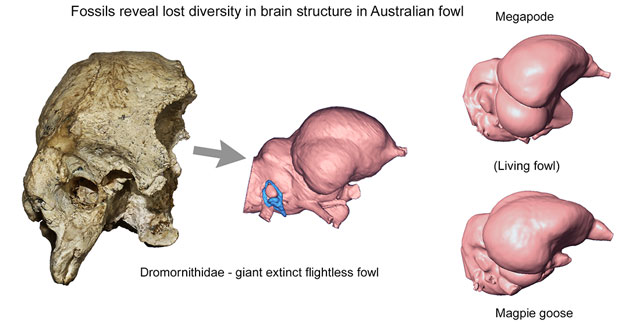Studying the Brains of Australia’s “Thunderbirds”
Australia boasts a weird and wonderful flora and fauna. Millions of years of isolation has led to the land “down under” evolving a very unique biota, perhaps most marked by the abundance of marsupial mammals. Today’s fauna, remarkable as it might be, is overshadowed somewhat by the incredible megafauna that once existed on the continent.
Australia’s Giant “Thunderbirds”
For example, giant, flightless birds thrived and evolved into a myriad of different sized forms as climates and habitats changed. Some of these birds, members of the extinct family the Dromornithidae, were giants and have been nicknamed Australia’s giant “Thunderbirds” or even “Devil Ducks”. A newly published study examines the evolutionary development of “bird brains” in a bid to settle the phylogeny of these giant birds.

Mapping the Brains of “Mihirungs”
Scientists had puzzled over the phylogeny of these extinct birds for some time. Earlier studies suggested that they were related to waterfowl – hence one of their nicknames “Devil Ducks”. Researchers from Flinders University (Adelaide, South Australia), reconstructed the brains of a number of dromornithid genera in a bid to better understand the family’s origins and to learn more about their place in the Australian megafauna dominated prehistoric ecosystems.
One of the birds studied was the enormous Dromornis stirtoni, the largest of the “mihirungs” (the Aboriginal word for “giant bird”).

Plant-eater or Meat-eater?
Heavier than a polar bear (Ursus maritimus) Dromornis stirtoni is known from Upper Miocene deposits from Australia’s Northern Territory. Dromornis had a huge skull, more than half a metre long, but its brain was squeezed for space.
It possessed a big, powerful beak, but its diet along with the diets of other dromornithids remains a mystery. It could have fed on leaves, nuts and fruit, or perhaps it was a predator. The lack of a “hook” and the absence of talons in this and other species suggests that these flightless birds were probably not hypercarnivores.
Examining Bird Brains (Australia’s Giant “Thunderbirds”)
Writing in the academic journal “Diversity”, the researchers examined the craniums of giant “Thunderbirds” looking at a variety of genera including the earliest Dromornis murrayi from the Late Oligocene to Dromornis planei and Ilbandornis woodburnei from the middle Miocene Epoch and Dromornis stirtoni, that roamed northern Australia around 7 million years ago (Messinian, the last stage of the Miocene).

Related to Gamefowl (Galliformes)
The researchers conclude that these birds were probably more closely related to gamefowl (Galliformes) than they were to waterfowl (Anseriformes).
Commenting on the research, one of the authors Dr Warren Handley (Flinders University) stated:
“Together with their large, forward-facing eyes and very large bills, the shape of their brains and nerves suggested these birds likely had well-developed stereoscopic vision, or depth perception, and fed on a diet of soft leaves and fruit. The shape of their brains and nerves have told us a lot about their sensory capabilities, and something about their possible lifestyle which enabled these remarkable birds to live in the forests around river channels and lakes across Australia for an extremely long time.”
An Evolutionary Experiment
The researchers suggest that the Dromornithidae were the result of birds distantly related to chickens getting a free reign in evolutionary terms on the isolated continent. They took a very different evolutionary path when compared to their relatives the megapodes which still exist in Australasia.
The researchers postulate that the range in body sizes exhibited by dromornithids were due to climate change and the availability of food within the ecosystem. The Late Miocene was a period of dramatic climate change with the continent becoming more arid and cooler. Rainforests retreated and were replaced by more open woodlands, these changes may have played a role in the evolution of giant forms such as D. stirtoni.
Everything Dinosaur acknowledges the assistance of a media release from Flinders University in the compilation of this article.
The scientific paper: “Endocranial Anatomy of the Giant Extinct Australian Mihirung Birds (Aves, Dromornithidae)” by W. D. Handley and T. H. Worthy published in Diversity.
Visit the Everything Dinosaur website: Everything Dinosaur.

